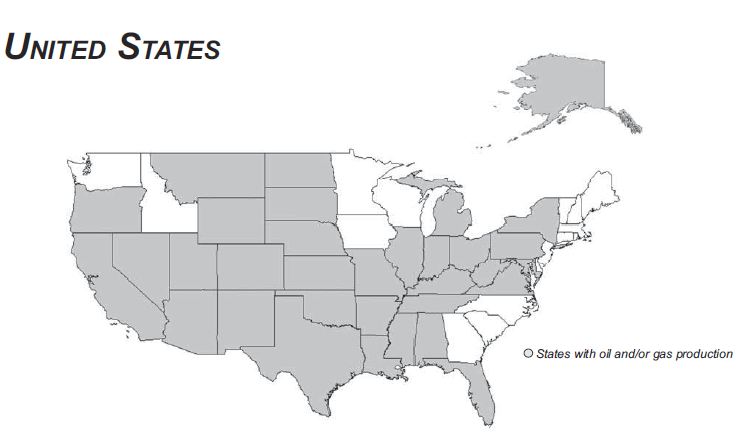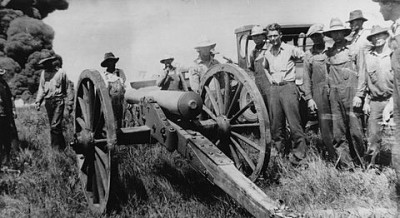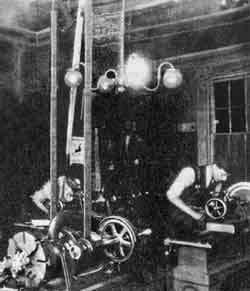December 11, 1950 – Federal Offshore grows beyond Cannon Shot –
After decades of controversy and a 1947 U.S. Supreme Court decision, the federal government’s “paramount rights” offshore were established beyond a three nautical mile limit, an 18th century precedent based on the theoretical maximum range of a smooth-bore cannon. The nation’s highest court prohibited any further offshore development without federal approval. In 1954, the Bureau of Land Management held the first Outer Continental Shelf lease sale, earning the government almost $130 million.
Learn more in Offshore Petroleum History.
December 11, 1972 – First Geologist walks on Moon
Astronaut and geologist Harrison “Jack” Schmitt stepped on the moon, joining Apollo 17 mission commander Eugene Cernan. Lunar experiments included a surface gravimeter to measure buried geological structures near the landing site. Schmitt also returned with the largest lunar sample ever collected.

Geologist Harrison “Jack” Schmitt examined a boulder at the Apollo 17 Taurus-Littrow Valley lunar landing site in December 1972. Photo courtesy NASA.
Schmitt, who in 1964 received a PhD in geology from Harvard, was the first and last scientist on the moon, according to Cernan. When they left the Taurus-Littrow Valley landing site on December 14, 1972, he and the lunar geologist were the last of 12 men to walk on the moon. The 19th century petroleum product kerosene fueled all of the launches.
December 13, 1905 – Hybrids evolve with Gas Shortage Fears
“The available supply of gasoline, as is well known, is quite limited, and it behooves the farseeing men of the motor car industry to look for likely substitutes,” proclaimed the monthly journal Horseless Age.

An early hybrid, this 1902 Porsche used a gas engine to generate electricity to power motors mounted on the front wheel hubs.
The magazine, first published in 1895, described early motor technologies, including the use of compressed air propulsion systems, electric cars, steam, and diesel power — as well as hybrids.
About the time of the first American auto showin late 1900, engineer Ferdinand Porsche introduced his gas-electric “Mixte” in Europe. The hybrid used a four-cylinder gasoline engine to generate electricity. The engine powered two three-horsepower electric motors mounted on the front wheel hubs. The car could achieve a top speed of 50 mph.
December 13, 1931 – Oilfield discovered in Conroe, Texas
Independent producer George Strake Sr. completed the South Texas Development Company No. 1 well eight miles southeast of Conroe, Texas, where he had leased 8,500 acres. By the end of 1932 the oilfield was producing more than 65,000 of barrels of oil a day. But disaster struck in the Conroe field in 1933 when derricks and equipment collapsed into a burning crater of oil. The fire would be put out thanks to relief wells drilled by George Failing and his newly patented truck-mounted drilling method.
Learn more in Technology and the Conroe Crater.
December 13, 1985 – Route 66 decertified
Route 66, the “Mother Road” of modern highways since 1926, was decertified by the American Association of State Highway and Transportation Officials (AASHTO), which also voted to remove all Route 66 signs. Once stretching more than 2,400 miles from Illinois to California, the historic route was trailblazed in 1857 by a War Department expedition that included camels as pack animals.
By World War II, automobiles and trucks on the iconic roadway “helped to facilitate the single greatest wartime mobilization of labor in the history of the nation,” according to the National Park Service (NPS). By 1985, Route 66’s narrow asphalt paving and antiquated structure had been bypassed by the interstate system.
Learn more U.S. transportation history in America on the Move.
December 14, 1981 – Dowsing No Help in Minnesota Oil Search
Seeking oil investors, a Minnesota promoter proclaimed that dowsing with copper wires had located petroleum deposits in Nobles County, according to the Minneapolis Tribune, which reported the promoter had hired, “a Texas oilman and evangelist to lead a prayerful search for oil.” Despite no geological evidence, local investors paid $175,000 to drill a well that found no indication of oil or natural gas after reaching a depth of 1,500 feet.

Minnesota is one of 17 states without any oil or natural gas production, according to the Independent Petroleum Association of America.
The Minnesota Geological Survey had reported in 1980 that of the state’s 17 exploratory wells drilled, “in suitable geologic settings,” none discovered commercial quantities of oil. The survey concluded, “the geologic conditions for significant deposits of oil and gas do not exist in Minnesota.”
December 17, 1884 – Fighting Oilfield Fires with Cannons
“Oil fires, like battles, are fought by artillery” proclaimed an article in The Tech, a student newspaper of the Massachusetts Institute of Technology. “A Thunder-Storm in the Oil Country” featured the reporter’s firsthand account of the problem of lightning strikes in America’s oilfields.

As the petroleum industry expanded westward, frequent lightening strikes in the Great Plains caused oil tank fires. Photo courtesy Kansas Oil Museum. El Dorado, Kansas.
The MIT article not only reported on the fiery results of a lightning strike, but also the practice of using Civil War cannons to fight such conflagrations. Shooting a cannon ball into the base of a burning tank allowed oil to drain safely into a holding pit until the fire died out. “Small cannons throwing a three-inch solid shot are kept at various stations throughout the region for this purpose,” the article noted.
Learn more in Oilfield Artillery fights Fires.
December 17, 1903 – Natural Gas contributes to Aviation History
A handmade engine burning 50-octane gasoline for boat engines powered Wilbur and Orville Wright’s historic 59-second flight into aviation history at Kitty Hawk, North Carolina. The brothers’ “mechanician,” Charlie Taylor, fabricated the 150-pound, 13-horsepower engine in their Dayton, Ohio, workshop.

Powered by natural gas, a three-horsepower engine drove belts in the Wright workshop.
The workshop included a single cylinder, three-horsepower natural gas-powered engine that drove an overhead shaft and belts that turned a lathe, drill press — and an early, rudimentary wind tunnel. Natural gas was piped from a field in Mercer County, about 50 miles northwest.
Learn about advances in high-octane aviation fuel in Flight of the Woolaroc.
December 17, 1910 – Petrolia Oilfield discovered in North Texas
Although traces of oil had been found as early as 1904 in Clay county, Texas, a 1910 gusher revealed an oilfield soon named after one of America’s earliest petroleum boomtowns, Petrolia, Pennsylvania. The well southeast of Wichita Falls produced 700 barrels of oil a day from a depth of 1,600 feet.
Annual oil production peaked in 1914 as discoveries at Electra and Burkburnett overshadowed the Petrolia field (see Pump Jack Capital of Texas), according to David Minor of the Texas State Historical Association (TSHA). “Drilling continued, however, as the field turned out to hold the largest known reserve of natural gas in the state,” Minor explained, adding that gas pumped to nearby towns contained .1 percent helium.
“In 1915 the United States Army built the first helium extraction plant in the country at Petrolia, and for several years the field was the sole source of helium for the country,” Minor reported in the TSHA article “Petrolia Oilfield.”
Learn more about helium’s association with natural gas in Kansas “WInd Gas” Well.
_______________________
Recommended Reading: Apollo and America’s Moon Landing Program: Apollo 17 Technical Crew Debriefing (2017); Electric and Hybrid Cars: A History
(2010); Texas Oil and Gas, Postcard History
(2013); Fire on the Horizon: The Untold Story of the Gulf Oil Disaster (2011); The Wright Brothers
(2016); Winners’ Viewpoints: The Great 1927 Trans-Pacific Dole Race
(2009); Helium: Its Creation, Discovery, History, Production, Properties and Uses (2022).
Top history books of 2023 — Your Amazon purchase benefits the American Oil & Gas Historical Society. As an Amazon Associate, AOGHS earns a commission from qualifying purchases.
_______________________
The American Oil & Gas Historical Society (AOGHS) preserves U.S. petroleum history. Become an AOGHS annual supporting member and help maintain this energy education website and expand historical research. For more information, contact bawells@aoghs.org. Copyright © 2023 Bruce A. Wells. All rights reserved.


